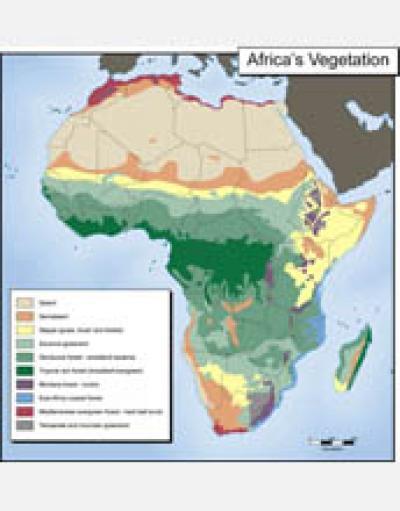Scientists using chemical isotopes in ancient soil to measure prehistoric tree cover--in effect, shade--have found that grassy, tree-dotted savannas prevailed at most East African sites where human ancestors and their ape relatives evolved during the past six million years.
"We've been able to quantify how much shade was available in the geological past," says University of Utah geochemist Thure Cerling, lead author of a paper titled "Woody cover and hominin environments in the past 6 million years" on the results in this week's issue of the journal Nature.
"It shows there have been open habitats for the last six million years in the environments in East Africa where some of the most significant early human fossils were found.
"Wherever we find human ancestors, we find evidence for open habitats similar to savannas--much more open and savanna-like than forested."
Scientists have spent a century debating the significance of open, savanna landscape in human evolution, including the development of upright walking, increased brain size and tool use.
Part of the problem has been an imprecise definition of "savanna," which has been used to describe "virtually everything between completely open grasslands and anything except a dense forest," Cerling says.
He adds that the most common usage is a fairly open, grassy environment with many scattered trees--a grassland or wooded grassland.
In the study, Cerling and colleagues developed a new way to quantify the openness of tropical landscapes. This is the first method to quantify the amount of canopy cover, the basis for deciding whether something is savanna.

Geochemist Thure Cerling developed a new way of measuring ancient tree cover using fossil soils.
(Photo Credit: Lee Siegel, University of Utah)
The National Science Foundation (NSF) and the Leakey Foundation funded the study.
"The development of a paleo-shade proxy for soil temperature and woody cover, and its application to ancient fossil sites, reinforces the long-held theory that the roots of human origins are in the open grassland/savanna environments of East Africa," says H. Richard Lane, program director in NSF's Division of Earth Sciences.
Adds Kaye Reed of NSF's Division of Behavioral and Cognitive Sciences, "These investigators have done an amazing job of collecting modern comparative isotope and soil temperature samples to compare with paleosol [fossil soil] samples from hominin localities. Their newly developed method for calculating 'paleo-shade' is very innovative."
Cerling does not dispute that East African savannas became more expansive within the past two million years, or that human ancestors and relatives likely spent time in narrow "gallery forests" along river corridors.
But he says the new method shows that grasslands and wooded grasslands--savannas--have prevailed for more than six million years in the cradle of humanity, with tree cover less than about 40 percent at most sites.
By definition, woodland has more than 40 percent tree cover; forest has more than 80 percent tree cover.
"In some periods, it was more bushy, and other times it was less bushy," he says.
"Hardly anything could have been called a dense forest, but we can show some periods where certain environments were consistently more wooded than others.
"We find hominins in both places. How early hominins partitioned their time between 'more open' and 'more closed' habitats is still an open question."
Cerling says that even sparse woody canopy provided hominins with shade, some foods and refuge from predators.
Fossil evidence of hominins dates back 4.3 million years and possibly 6 million years, Cerling says. The new method was used to look for and find savanna up to 7.4 million years ago.
"Currently, many scientists think that before 2 million years ago, the region was forested, and that savanna conditions have been present only for the past 2 million years," Cerling says. "This study shows that during the development of bipedalism [about 4 million years ago] open conditions were present, even predominant."
Cerling conducted the study with biologists Samuel Andanje and David Kimutai Korir of the Kenya Wildlife Service; geologist Michael Bird of James Cook University, Cairns, Australia; University of Utah graduate students William Mace, Anthony Macharia and Christopher Remien; and Jonathan Wynn of the University of South Florida, Naomi Levin of Johns Hopkins University and Jay Quade of the University of Arizona.
The new method was developed by correlating carbon isotope ratios in 3,000 modern soil samples with satellite photos of tree and vegetation cover at 75 tropical sites worldwide--half in Africa--representing closed forest to open grassland.
That allowed scientists to determine the percent of tree and woody shrub cover millions of years ago based on carbon isotope ratios in fossil soils known as paleosols.
"This study is based on the geological axiom that the present is the key to the past," says Cerling. "We assume soils in the past had similar relationships to vegetation as what we observe today."
The researchers collected soil samples at Kenyan and Ethiopian sites and used published data on soil samples collected by others during the past decade at sites throughout the tropics.
Modern soil samples came from national parks and reserves and non-agricultural areas so that carbon isotope ratios reflected natural vegetation.
The ratio of rare carbon-13 to common carbon-12 in decayed plant material in soils reveals the extent to which the landscape was covered by plants that use what is known as the C3 pathway of photosynthesis, versus plants that use C4 photosynthesis.
Trees, shrubs, herbs, forbs and cool-season grasses are C3 plants, which include beans and most vegetables. C4 plants are warm-season or tropical grasses that dominate savannas, and plants called sedges. C4 plants have a higher ratio of carbon-13 than C3 plants.
The isotope composition of fossil soil gives a measure of the total makeup of the ecosystem in terms of how much was canopy versus how much was open landscape, Cerling says.
In a forest, even soil from open gaps shows the C3 signature because of non-woody C3 plants growing there, while on a savanna, soil from under a C3 tree will show the C4 signature because of grasses growing under the tree.
Cerling and colleagues used the new method to analyze fossil soils and infer plant cover back to 7.4 million years ago, a period that includes the time when human ancestors and apes split from a common ancestor.
Their analysis of 1,300 fossil soil samples from sites at or near where human ancestors and their relatives evolved shows that more than 70 percent of the sites had less than 40 percent woody cover, meaning they were wooded grasslands or grasslands. Less than one percent of the samples reflected sites where tree cover exceeded 70 percent.
"Therefore, 'closed' forests (more than 80 percent woody cover) represent a very small fraction of the environments represented by these paleosols," the researchers write.
"We conclude there have been open savannas all the time for which we have hominin fossils in the environments where the fossils were found during the past 4.3 million years--the oldest fossils now accepted as human ancestors," Cerling says.
The researchers also created vegetation chronologies of the Awash Valley of Ethiopia and the Omo-Turkana Basin of Ethiopia and Kenya--home to many fossils of human ancestors, including Ardipithecus, Australopithecus, Paranthropus and our own genus, Homo.
They found that during the past 7.4 million years, woody cover ranged from 75 percent (closed woodlands) down to 5 percent or less (open grasslands), but significant areas with woody cover below 50 percent (savanna woodlands to savanna grasslands) were consistently present.
Fossils of early humans and their ancestors and extinct relatives have been found in both wooded and open environments in East Africa.
Even 4.3-million-year-old Ardipithecus--which lived in the woods, according to its discoverers--had a small component of grasses or other C4 plants in its diet, says Cerling.
"The fact that it had this means it was going into the savanna," he says, "unless it was eating takeout food."

Savanna and woodland extend across a broad swath of East Africa.
(Photo Credit: AccessAfrica)
Source: National Science Foundation